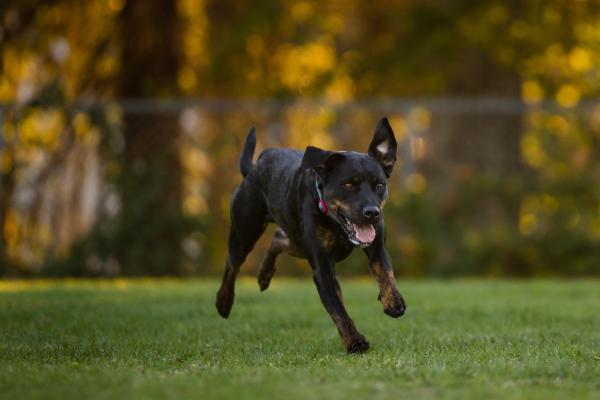
Vehicle chasing ranks among the most dangerous and frustrating behaviors dogs develop, and one of the hardest to break. It happens to devoted owners with otherwise well-trained dogs, crossing breed and age boundaries with frustrating consistency. However, this isn't just about disobedience. Your dog isn't ignoring you out of spite or stubbornness. Understanding these underlying motivations is the first crucial step toward creating an effective solution.
In this AnimalWised article, we'll explore why do dogs chase cars and bikes, and how to fix it.
Why do dogs chase moving vehicles?
Dogs don't just wake up one day and decide to chase moving vehicles. There's almost always a deeper instinct or emotion driving this behavior. This is why identifying the right trigger makes all the difference in fixing the problem. Let us look at some of the most common reasons:
1. Fear:
Ever notice how some dogs seem genuinely scared of vehicles, yet paradoxically run toward the very thing that frightens them? Although it might seem backwards, it makes perfect sense from your dog's perspective.
Fear-based chasing typically develops from poor early socialization or genetic tendencies toward fearfulness. In the case of rescue dogs, there is commonly some sort of past trauma involving vehicles. Your dog isn't being stubborn or disobedient, they're literally responding to what they perceive as a threat.
You'll spot this type of chasing by watching your dog's body language. A fearful dog typically shows a lowered body stance with weight shifted backward, tail tucked between legs, and ears pinned back against the head. They might freeze or startle when first noticing a vehicle, followed by frantic barking that sounds almost desperate.
2. Territorial behavior:
Some dogs couldn't care less about cars on neutral ground, but the minute a vehicle passes near their property, they might respond by chasing them. This is because your dog views your property as their responsibility.
You can spot this kind of behavior because it mostly happens near home, not on walks elsewhere. These dogs typically use intense, rapid-fire alarm barks that don't pause, and show similar reactions to other "intruders". Interestingly, they often display completely calm behavior around vehicles in neutral locations.
3. Age:
Puppies chase stuff, all kinds of stuff, simply because moving things are fun to chase. This looks cute at first, but it quickly becomes dangerous when the "moving thing" weighs two tons and has zero ability to avoid your adventurous puppy.
4. Hunting instincts:
Some dogs aren't afraid of vehicles, nor are they defending territory. They're hunting them. And that's a whole different ball game. Predatory chasing taps into your dog's hardwired hunting sequence, the same instincts that helped their ancestors survive.
Unlike fearful chasers, predatory chasers often stare intently before chasing, with a focused gaze. They move silently or with minimal noise during pursuit. They frequently target joggers, cyclists, and small animals with similar intensity.
5. Stress:
Sometimes vehicle chasing isn't about fear, territory, play, or predation. It's simply an outlet for pent-up energy and stress.
Dogs living with chronic anxiety or insufficient stimulation often develop repetitive behaviors, and vehicle chasing can become a stress release valve.
Before assuming your dog's chasing stems from one of the other causes, take a hard look at their overall lifestyle. Do they get enough physical exercise for their breed and age? Are they mentally stimulated? Is their home environment predictable and calm? Have there been recent changes to their routine? A bored, anxious dog will find something to do, and that something rarely aligns with what we want.

How to stop your dog from chasing
No matter which chasing category fits your dog, these practical approaches help address the behavior safely and effectively. But before diving into training, you need immediate safety measures. Use proper equipment, your regular collar won't cut it.
A front-clip harness gives you better control without risking tracheal damage during lunges. For serious chasers, consider a properly fitted head halter. Keep your dog on leash near roads. Always.
Also, walk strategically, early mornings or less-traveled routes might mean the difference between a pleasant walk and a dangerous situation.
How to train your dog to stop chasing:
The most effective training approach combines management with gradual desensitization. First, identify how far from passing vehicles they can remain calm. This might be 50 feet for some dogs or 200 feet for others. Start training at this distance, rewarding calm behavior when vehicles pass.
Don't wait for your dog to react, catch them being good. Gradually decrease distance as your dog shows consistent calmness. Expect occasional setbacks, because progress rarely follows a straight line. Training takes time. A correction or two won't fix this problem, but consistent, methodical practice absolutely can improve even severe cases.
Some chase behaviors warrant professional help, particularly if your dog has actually caught or bitten a moving vehicle or cyclist, the behavior is getting worse despite your efforts, safety is seriously compromised, or you've been working consistently for 2-3 weeks with zero improvement.
Learn more about positive reinforcement in dogs in the following article.
If you want to read similar articles to Why Do Dogs Chase Cars and Bikes?, we recommend you visit our Behavioral problems category.